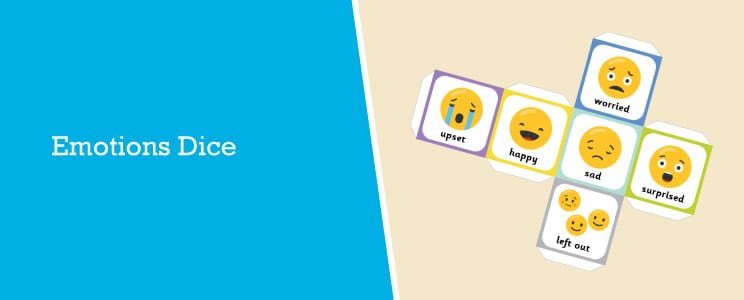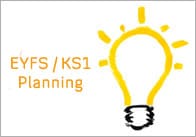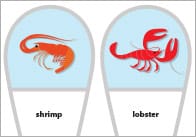How to Use an Emotions Dice: 12 Engaging Activities for Children

Using an emotions dice with children is a fantastic way to help them explore emotional well-being and mental health in a fun, interactive way. This guide explores creative ways to use an emotions dice to start meaningful conversations, build self-awareness, and encourage empathy and emotional intelligence. These ideas have been gathered from experienced early years professionals.
If you don’t have an emotions dice, then you might like to download and print one of ours. We have a few to choose from in our ‘dice and spinners’ section but our most popular is probably the emoji themed dice as shown below.

1. Emotion charades
How to play
Roll the emotions dice and read out the emotion shown.
The child must act out the emotion without speaking (e.g., if they roll ‘happy,’ they might jump and smile).
The rest of the group must guess the emotion.
Discuss how our body language and expressions show how we feel.
Learning outcome
- Helps children recognise emotions in themselves and others.
- Encourages empathy and social awareness.
2. ‘When did you feel…?’ story sharing
How to play
Roll the emotions dice and ask: “Can you think of a time when you felt this way?”
Each child shares a real or made-up story about when they experienced that emotion.
Discuss ways to manage emotions (e.g. what helps when we feel sad or angry?).
Learning outcome
- Encourages self-reflection and emotional vocabulary.
- Helps children identify coping strategies.
3. ‘What would you do?’ problem-solving game
How to play
Roll the emotions dice and pick a scenario (e.g. “You lose your favourite toy” or “A friend shares their snack with you”).
Ask: “If you felt [X emotion], what could you do?”
Children suggest ideas on how to manage emotions (e.g., deep breathing, talking to an adult, playing with a friend).
Learning outcome
- Teaches emotional regulation skills.
- Encourages problem-solving and resilience.
4. Feel-good dice toss
How to play
Each side of the emotions dice also has a matching well-being action (e.g. for ‘sad,’ it might say “Give yourself a hug” or for ‘angry,’ it might say “Take 5 deep breaths”).
The child rolls and must act out the well-being action to manage the emotion.
Learning outcome
- Helps children learn practical strategies for managing emotions.
- Encourages self-care and kindness.
5. Draw your feelings
How to play
Roll the emotions dice and ask children to draw a picture representing that feeling.
It could be:
A face showing the emotion
A situation that makes them feel that way
Colours and shapes that match the mood
Once finished, they explain their drawing to the group.
Learning outcome
- Encourages creative expression of emotions.
- Helps children visualise feelings in a safe way.
6. Mirror, mirror!
How to play
Roll the emotions dice and have children look in a mirror and make that facial expression.
Ask: “What happens to your eyes, mouth, and eyebrows?”
Discuss how we can tell how others are feeling just by looking.
Learning outcome
- Improves self-awareness and recognising emotions in others.
- Helps with social skills and empathy.
7. ‘Pass the dice’ group reflection
How to play
Sit in a circle and pass around the emotions dice.
When a child catches it, they roll and answer:
“What helps you when you feel [X emotion]?”
Continue until everyone has shared.
Learning outcome
- Encourages children to share and learn coping strategies.
- Creates a safe space for emotional expression.
8. ‘Emotion detective’ game
How to play
Roll the emotions dice and ask: “Can you find someone showing this emotion?”
Children look around the room to spot a classmate’s facial expression that matches.
Once they find someone, they can ask, “Are you feeling [emotion]?”
The child they guessed can respond with “Yes, because…” or “No, I’m feeling…”
Learning outcome
- Helps children read facial expressions and body language.
- Encourages social awareness and understanding of others’ emotions.
9. ‘Emoji moves’ – movement & emotion game
How to play
Roll the emotions dice and ask: “How would this emotion move?”.
You could make up a set of moves as a group that everyone must follow for each emotion or you could let each child make up their own moves.
For instance, happy = hopping, sad = slow walking, angry = stomping, loved = skipping, excited = jumping.
Once you’ve decided on the moves for each emotion, roll the dice and get the children to act out the emotion. You could speed up the rolling of the dice to add a sense of urgency and fun.
You could also add music to make it more engaging.
Learning outcome
- Encourages mind-body connection.
- Helps children express emotions through movement.
10. ‘Emotion jigsaw’ – matching feelings to situations
How to play
Create two sets of cards:
- One set with emotions (Happy, Sad, Angry, Scared, Excited, etc.)
- One set with scenarios (e.g., “It’s your birthday!” or “You lost your favourite toy.”)
A child rolls the dice, then picks a scenario card and decides if they match.
If the emotion and scenario don’t match, they can say, “Hmm, I think this feeling fits better!”
Learning outcome
- Helps children understand that different people can feel different emotions in the same situation.
- Encourages critical thinking and empathy.
11. ‘Feelings weather report‘
How to play
Roll the emotions dice and match the feeling to a type of weather:
- Happy = Sunny
- Sad = Rainy
- Angry = Stormy
- Excited = Rainbow
- Calm = Snowy
Ask: “Why does this emotion feel like this weather?”
Children can draw their “feelings weather” for the day.
Learning outcome
- Helps children visualise emotions using familiar concepts.
- Supports self-expression and emotional literacy.
12. ‘Emotion treasure hunt‘
How to play
Write different emotions on small cards and hide them around the room.
A child rolls the emotions dice, then hunts for a card with the matching feeling.
When they find it, they act out the emotion or describe a time they felt that way.
Learning outcome
- Encourages active learning and emotional exploration.
- Adds a fun, interactive element to emotional education.
We hope you’ve found this list of classroom activities useful, if you have any further ideas you’d like to share then please get in touch.
FAQs
What is an emotions dice?
An emotions dice is a tool that helps children explore different feelings through play. Each side of the dice features a different emotion (e.g., happy, sad, angry, worried), allowing kids to express and discuss emotions in a fun and interactive way.
How can an emotions dice help with emotional well-being?
An emotions dice helps children develop emotional intelligence, self-awareness, and empathy by encouraging conversations about feelings. It also supports social-emotional learning (SEL) and mental health development in early childhood.
What are some signs that a child is struggling to express their emotions?
Some children find it difficult to express their emotions verbally, but there are clear signs that may indicate they need extra support:
- Frequent tantrums or emotional outbursts when they cannot communicate their feelings.
- Withdrawal from social interactions, avoiding eye contact, or preferring to be alone.
- Difficulty labelling their own emotions or responding to questions like “How do you feel?”
- Physical complaints such as stomachaches or headaches without a medical cause.
- Lack of engagement in activities they normally enjoy.
- Changes in behaviour, such as becoming more anxious, clingy, or aggressive.
A useful tool for assessing emotional well-being is the Leuven Scale of Emotional Well-Being, which is often used in early childhood education. This scale helps educators and caregivers evaluate how secure, relaxed, and emotionally engaged a child appears, ranging from:
- Low well-being (e.g., anxious, withdrawn, emotionally flat)
- Moderate well-being (e.g., neutral, sometimes engaged, but with occasional signs of distress)
- High well-being (e.g., happy, relaxed, expressive, and socially engaged)
By observing a child’s emotional well-being using this scale, parents and educators can identify children who may need additional emotional support and provide targeted interventions, such as emotion-focused activities, social-emotional learning strategies, or one-on-one discussions.
If these signs persist, it may be beneficial to speak with a teacher, school counsellor, or child psychologist to ensure the child receives the right support.
How can parents and teachers model healthy emotional expression for children?
Adults play a crucial role in teaching emotional expression to children by:
- Demonstrating Emotional Vocabulary: Openly discussing their own feelings and labelling them appropriately.
- Practicing Active Listening: Giving full attention when a child expresses emotions, validating their feelings.
- Modelling Coping Strategies: Showing healthy ways to manage emotions, such as deep breathing or taking a break when upset.
By exhibiting these behaviours, adults provide a blueprint for children to emulate in their own emotional development.
Where can I download a printable emotions dice?
You can download a printable emotions dice here. We also have a ‘spinner’ version of this resource. Spinners are a great alternative to dice, and can be assembled using a paperclip and a split pin. All of the emotions dice games listed above could work equally well with a spinner.
Want more printable resources to help children understand emotions? Check out our full range of emotions dice games and social-emotional learning (SEL) tools.
Popular Teaching Resources
Stay Up To Date
Sign up for our newsletter and we’ll let you know when we create new early years resources.





